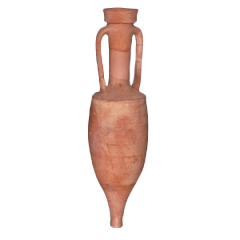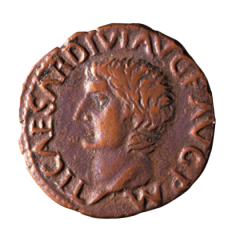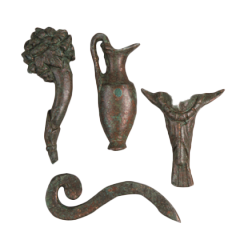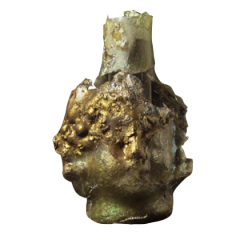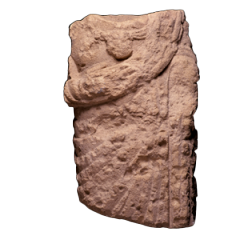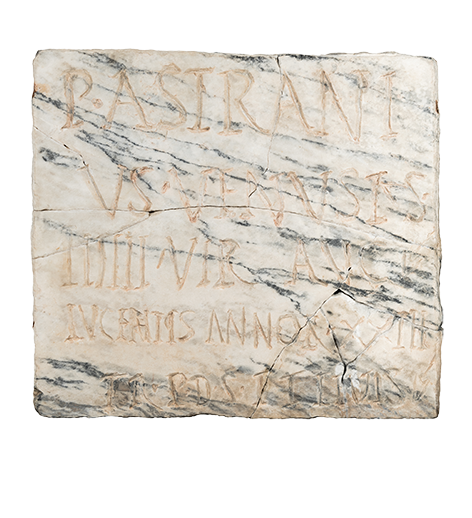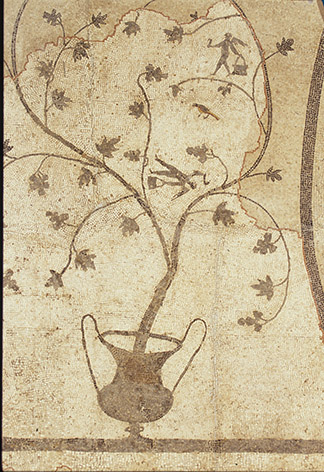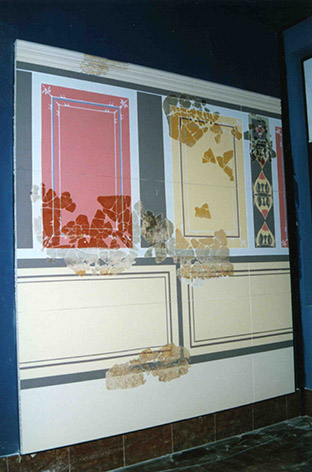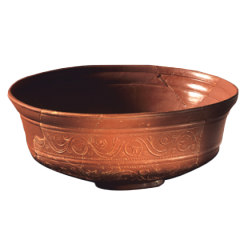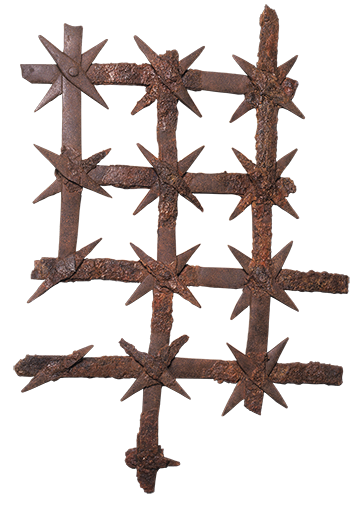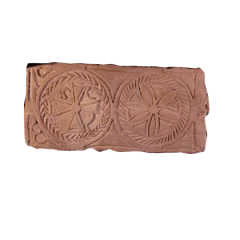
Visigothic reliefs
Cerro de Las Balsas (Albufereta, Alicante) Sandstone h: 97 cm; w: 46 cm; d: 12 cm h: 66 cm; w: 50 cm; d: 13 cm Roman culture 7th century AD: 46 cm; w: 12 cm h: 66 cm; h: 50 cm; w: 13 cm Roman culture 7th century AD.
Two sandstone slabs decorated with Christian symbols. One is intact, rectangular in shape and shows two tangent circles. The outer edge of the slab and the circles are marked by an incised line. The first is composed, from the outside to the inside, of a smooth circumference, an oblique stripe and a six-pointed star, with bevelled fusiform figures carved between them. The second, in the same order, consists of a smooth circumference, a circular motif in the form of a palm or laurel wreath enclosing a cross with triangular arms with recessed ends and on the sides of the upper arm the letters C and S. On one side, between this circle and the edge of the slab, the letters alpha, poorly drawn, and omega appear at the ends.
The next slab is preserved split. The decorative composition would be similar to the previous one, although it only shows one of the circles and part of the adjoining one. The best-preserved motif consists of a palm-shaped circle, similar to the slab described above, between two plain circles. The central relief is a star, the ends of which form four arrowheads joined by a cross. In the quadrants between the star and the inscribed circumference are four figures in spindle-shaped relief, the points of which almost touch the vertices of the star. Of the incomplete circular motif, only the smooth outer circle and the immediate circle with oblique stripes are visible. The slab would have been marked near the edge by an incised line, although one of the corners is missing.
The decoration of the slabs, as pointed out at the time by E. Llobregat points to Visigothic workmanship, citing parallels present in several cult buildings from this period. Similar pieces found recently include those from the Visigothic basilica of Tolmo de Minateda. It has been suggested that they could be doorways or part of an ornamental frieze. The absence of carving on one of the faces may point to the latter function. The slabs suggest the existence of a religious building of some importance erected on the right bank of the Albufereta in the 7th century. In this sense, it should be pointed out that these are very important pieces from the Visigothic culture of Alicante which are not completely out of context. On the one hand, there is news, with graphic representation, of a construction that can be interpreted as a funerary crypt from the Visigothic period, and furthermore, hundreds of burial sites have been documented in the Cerro de Las Balsas, covering the entire Late Antique period and even some Early Medieval ones, which suggests an important settlement.
The reuse of the slabs in a burial determines that this would be later than the amortisation of the construction of which they were part, perhaps well into the 8th century.
C.S.: 6378
LLOBREGAT CONESA, E. 1970.
LLOBREGAT CONESA, E. 1985.
Highlights Sala Cultura Romana
- ................................................. Cerro de Las Balsas (Albufereta, Alicante) Sandstone h: 97 cm; w: 46 cm; d: 12 cm h: 66 cm; w: 50 cm; d: 13 cm Roman culture 7th century AD: 46 cm; w: 12 cm h: 66 cm; h: 50 cm; w: 13 cm Roman culture 7th century AD.
- ................................................ Tossal de la Cala (Benidorm) Ceramic h:118 cm; w. 32 cm Roman culture Late 2nd - early 1st century BC: 32 cm Roman culture Late 2nd - early 1st century BC Typology Dressel 1, subtype B.
- ................................................. Isidro Albert Collection Bronze d: 2'12 cm; w: 4'7 g; d.w.:12 h Roman culture 22-23 A.D. 5th issue
- ................................................. Lucentum, Tossal de Manises (Alicante) Bronze Plate: h: 21'5 cm; w: 5'7 cm; d: 0'3 cm Bucranes: h: 7-7'7cm; w: 6'2 cm; d: 1-1'6 cm Urceus: h: 8'7 cm ; w : 3'9 cm; e: 0'8 cm Lituus: h: 10'5 cm; a: 3'5 cm; e: 0'4 cm Cornucopia: h: 9'1cm; a: 4 cm; e: 1'5 cm Roman culture 1st century AD.
- ................................................. Necropolis of El Albir (l'Alfaç del Pi) Glass h: 7'5 cm; w: 4'1 cm; d: 3'6 cm Roman culture 5th century AD: 4'1 cm; e: 3'6 cm Roman culture 5th century AD.
- ................................................. Lucentum, Tossal de Manises (Alicante) Sandstone h: 42 cm; w: 24.5 cm, d: 12 cm Roman culture Second half of the 1st century BC.
- ................................................. Lucentum (Tossal de Manises, Alicante)White marble with grey veinsh: 31.11cm; h: 28.4cm; w: 2cmRoman culture2nd century AD.
- ................................................. Baños de la Reina (Calpe, Alicante) Stone tesserae h: 264 cm; w: 288 cm Roman culture 2nd century AD.
- ................................................. Lucentum, Tossal de Manises (Alicante) Painting applied using the fresco technique on a lime mortar base. h: 305 cm; w: 265 cm h: 303 cm; w: 139 cm; d: 8 cm Roman culture First half of the 2nd century AD.
- ................................................. Lucentum (Tossal de Manises, Alicante) Ceramic h: 23.6 cm; w: 8.1 cm; d: 10.1 cm Roman culture Towards the first half of Nero's reign (50-60/65 BC).
- ................................................. Illeta dels Banyets (Alicante) Iron h: 72 cm; w: 49 cm; d: 3 cm Roman culture 2nd century AD: 49 cm; e: 3 cm Roman culture 2nd century AD.

